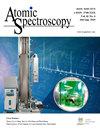A Highly Efficient Method For The Accurate And Precise Determination Of Zinc Isotopic Ratios In Zinc-Rich Minerals Using MC-ICP-MS
IF 2.3
2区 化学
Q1 SPECTROSCOPY
引用次数: 1
Abstract
This study proposes a highly efficient method for the direct determination of Zn isotopes in Zn-rich minerals, without the use of column chromatography, via multi-collector inductively coupled plasma mass spectrometry (MC-ICP-MS). Experiments (with or without column chromatography) were performed to evaluate the feasibility of directly obtaining non-deviated Zn isotopic ratios by MC-ICP-MS. For Zn isotopes determined without the use of column chromatography, the instrumental mass bias was corrected using the standard sample bracketing with Cu as the internal standard. The effects of acidity and concentration mismatch and the matrix effect were strictly assessed in a wet-plasma mode. The Long-term reproducibilities of δZn and δZn better than ± 0.03‰ (n = 42, 2 standard deviations (2s)) and ± 0.05‰ (n = 42, 2s), respectively, were achieved by repeatedly measuring the NIST Standard Reference Materials (SRM) 682 solution doped with trace matrix elements over four months. Zn-rich minerals determined without employing column chromatography displayed little drift in δZn and δZn values compared with minerals determined using column chromatography, with ΔZnwithout−with (ΔZnwithout-with = δZnwithout δZnwith) ranging from -0.04 to +0.01‰ and ΔZnwithout−with ranging from -0.06 to +0.01‰. These results suggest that non-deviated Zn isotopic ratios in Zn-rich minerals can be achieved without column chromatography due to the low contents of undesired matrix elements.MC-ICP-MS测定富锌矿物中锌同位素比值的高效方法
本研究提出了一种不使用柱色谱法,通过多收集器电感耦合等离子体质谱法(MC-ICP-MS)直接测定富锌矿物中锌同位素的高效方法。进行实验(有或没有柱色谱)以评估通过MC-ICP-MS直接获得未偏离的Zn同位素比率的可行性。对于不使用柱色谱法测定的Zn同位素,使用以Cu为内标的标准样品校正仪器质量偏差。在湿等离子体模式下严格评估酸度和浓度失配的影响以及基质效应。通过对掺有微量基质元素的NIST标准参考物质(SRM)682溶液进行4个月的重复测量,获得了δZn和δZn的长期重现性分别优于±0.03‰(n=42,2个标准偏差(2s))和±0.05‰(n=42,2s)。与使用柱色谱法测定的矿物相比,不使用柱色谱测定的富锌矿物的δ,ΔZnwithout−(ΔZnwith=δZnwithoutδZnwiths)范围为-0.04至+0.01‰,ΔZnwithin−范围为-0.06至+0.01。这些结果表明,由于不需要的基质元素含量低,富锌矿物中的锌同位素比例可以在不使用柱色谱的情况下实现不偏离。
本文章由计算机程序翻译,如有差异,请以英文原文为准。
求助全文
约1分钟内获得全文
求助全文
来源期刊

Atomic Spectroscopy
物理-光谱学
CiteScore
5.30
自引率
14.70%
发文量
42
审稿时长
4.5 months
期刊介绍:
The ATOMIC SPECTROSCOPY is a peer-reviewed international journal started in 1962 by Dr. Walter Slavin and now is published by Atomic Spectroscopy Press Limited (ASPL). It is intended for the rapid publication of both original articles and review articles in the fields of AAS, AFS, ICP-OES, ICP-MS, GD-MS, TIMS, SIMS, AMS, LIBS, XRF and related techniques. Manuscripts dealing with (i) instrumentation & fundamentals, (ii) methodology development & applications, and (iii) standard reference materials (SRMs) development can be submitted for publication.
 求助内容:
求助内容: 应助结果提醒方式:
应助结果提醒方式:


